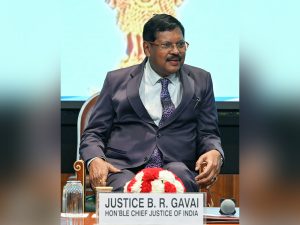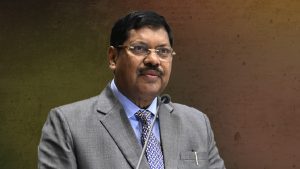Lawyer Attempts to Throw Object at CJI BR Gavai During Supreme Court Session
An unsettling incident unfolded in the Supreme Court on Monday, when a man dressed in a lawyer’s robe attempted to hurl an object — reported by some as a shoe, by others as a rolled-up paper — at Chief Justice of India BR Gavai during the morning session. The act, coupled with shouted slogans, caused a brief disruption before court security intervened and order was restored.
The Incident Details
The disruption occurred while cases were being mentioned before a bench headed by CJI Gavai. Eyewitnesses say the man approached the dais, removed his shoe, and attempted to throw it at the Chief Justice. Alternately, some observed him flinging what looked like a paper roll. During the commotion, the individual was heard shouting slogans such as “Sanatan Dharam ka apmaan nahi sahega Hindustan” — meaning India will not tolerate insult to Sanatan Dharma. He was promptly escorted from the courtroom by security personnel.
Despite the disturbance, CJI Gavai remained composed. According to reports, he instructed the lawyers present: “Don’t get distracted by all this. We are not distracted.” He later affirmed that such events do not affect him, and the court resumed proceedings without delay.
Possible Motivations and Background
The incident is viewed by many as a reaction to a controversy surrounding comments made by CJI Gavai in a recent hearing. During a case concerning the restoration of a 7-foot beheaded idol of Lord Vishnu in Khajuraho, the CJI reportedly told petitioners: “Go and ask the deity itself to do something. If you say you are a devotee, then pray now.” These remarks sparked strong reactions on social media, with critics accusing him of insensitivity toward religious sentiments.
In court, CJI Gavai clarified that his statement was made in the legal context of an archaeological site under the jurisdiction of the Archaeological Survey of India (ASI), and insisted he respected all religions. He also acknowledged that social media may have magnified the perception of his words beyond their intended legal meaning.
The lawyer’s dramatic action appears to be a direct protest against what he perceived as a disregard for religious sentiments. His chant — protesting perceived insult to Sanatan Dharma — suggests ideological motivations behind the attempt.
Court’s and Security Response
Security personnel reacted swiftly. The individual was removed before any harm could be done. The registrar’s office and Supreme Court security units took custody of him. The Delhi Police have been reported to coordinate with Supreme Court authorities to further investigate the incident, identify the person’s credentials, and assess whether legal action will be initiated.
Judicial observers noted the calm and firm response of CJI Gavai under pressure. He resisted being derailed by the theatrics and reclaimed courtroom dignity, enabling proceedings to continue.
Implications and Reflection
This dramatic episode underscores tensions in India’s public discourse, especially when matters of faith, law, and freedom of expression intersect. The attempt to attack a sitting Chief Justice — even symbolically — reflects the deep emotional and ideological currents that color debates in the country today.

From a judicial and institutional perspective, the incident will likely prompt a review of courtroom security protocols, especially in high-stakes cases touching on religion or identity issues. The judiciary must balance open access and transparency with ensuring the safety and dignity of its functionaries.
On a more symbolic level, the episode also serves as a warning: even in courts, emotions can spill over when people feel their sacred beliefs are challenged. It challenges legal professionals to remain disciplined, respectful and mindful of the power of words — whether spoken in judgment or in protest.
For Chief Justice Gavai, who assumed office in May 2025 and is scheduled to serve until November 2025, this event will likely add to the complex legacy of his tenure — where legal judgments, public statements and public perception are tightly intertwined. His response in the moment — calm, unfazed and firm — may bolster his reputation as a jurist who strives to maintain decorum and focus even amid provocation.
As investigations proceed, the legal community and the public await clarity on who was behind the attempt, his motives, and the consequences he may face under law. But beyond that, the episode itself stands as a dramatic reminder of how intensely India’s legal, political and religious fault lines can converge — even inside a courtroom.

